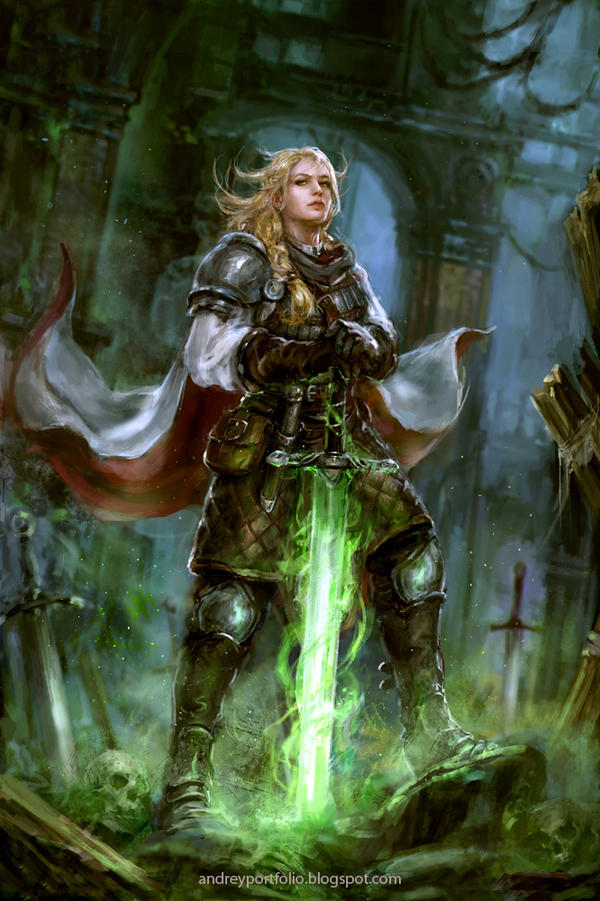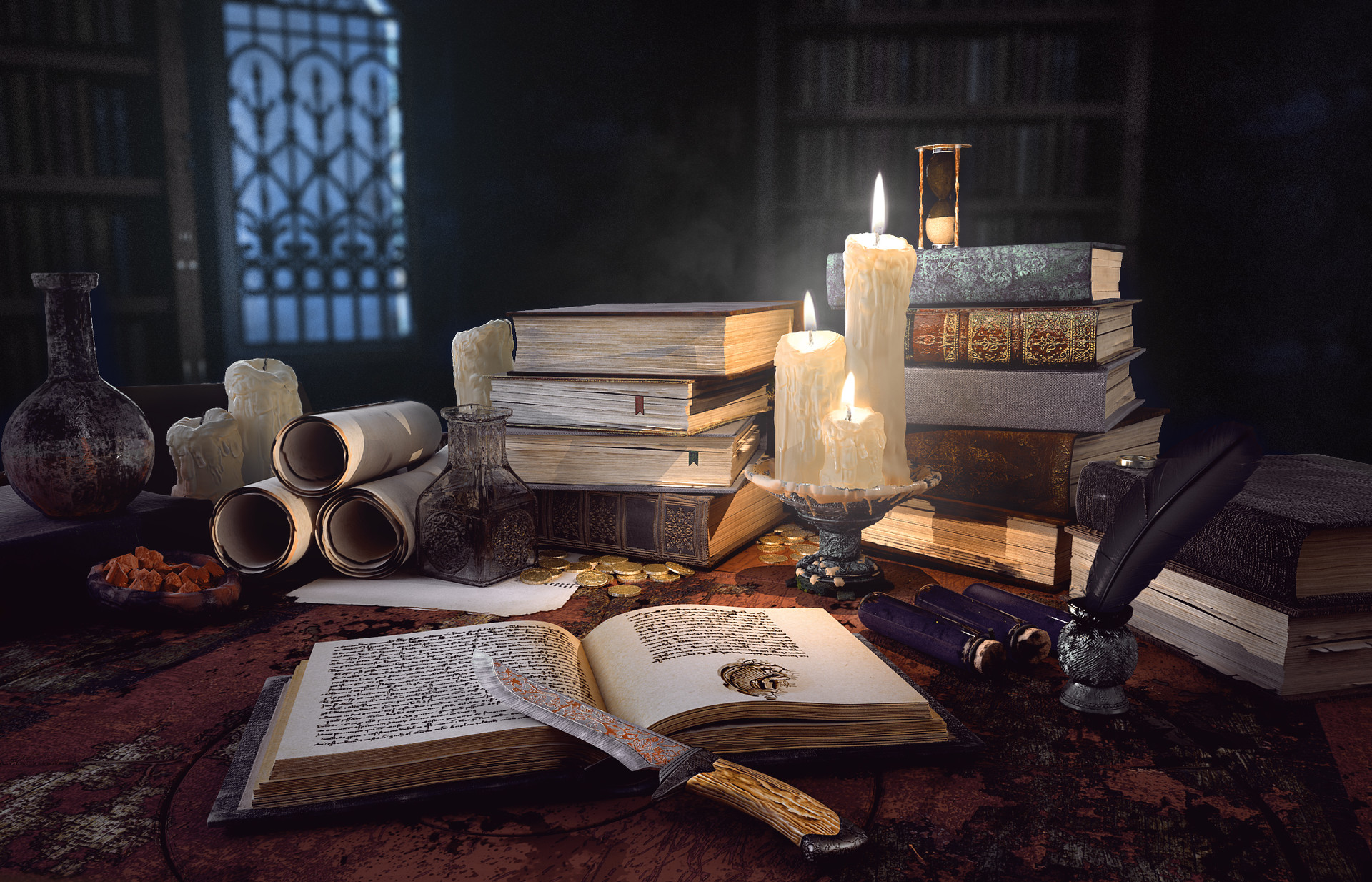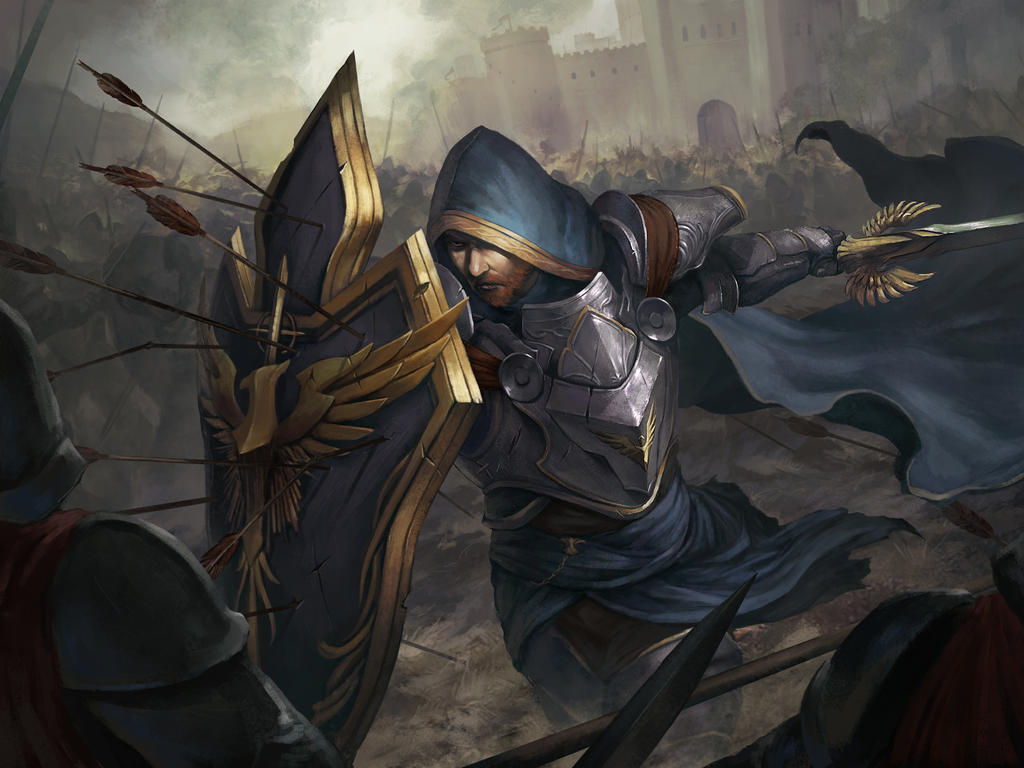Arcane Armsman
A young elven man sits peacefully under a tree on the side of the road. As a group of bandits emerge from the shadows, trying to take advantage of this unarmed traveler, the elven man snaps his fingers. Within seconds, a full suit of glistening white platemail apparates onto his body, and a massive greatsword covered in runes appears in his hands.
Surrounded by two huge trolls, a goliath stands firm with his two scimitars glowing brightly in his hands. With one fluid movement he launches one of his scimitars, sinking it deeply into one of the troll’s head. It stops in its tracks, screeching in pain as it struggles to remove the blade. He turns to the other, sword in hand, ready to face it one-on-one.
Three humans stare in awe at the gaping maw of an ancient red dragon. They see a bright, burning glow begin to emerge from its throat, and prepare to meet their gods. As the blazing fury of fire billows around them, they remain unharmed. Standing firmly in front of them clad in a knight’s breastplate, a woman’s shield is glowing red hot, blocking them from its destruction.
An arcane armsman combines their natural fighting abilities with long, intensive studies of the arcane. Unlike traditional magic users, armsmen use their powers to augment their weapons, armor, and bodies to push themselves beyond their limit in combat.
A Skillful Balance
Scholars and swordsmen alike, arcane armsmen spend much of their time studying their trade. They spend hours in the daylight perfecting their swordsmanship, and equally long nights engrossed in tomes, learning and creating beautifully intricate runes to fuel their magic. This leaves little free time, so most armsmen devote their entire lives to the craft.
Creating an Arcane Armsman
As you build your arcane armsman, think about two aspects of your character's background: Where did they learn the way of the arcane arts, and why did they choose to make it their life? Were they trained by a veteran armsman, perhaps from a royal knight? Or did you research these powers of your own volition, thirsting for a higher form of combat?
You may have been trained by a wise old noble, searching for his successor among the commoners. Maybe you were sent to a knight's academy as a young adult, being taught the ancient history of magic alongside the art of war. Or perhaps you simply heard tell of legendary warriors who can channel the weave, and worked incessantly to become one yourself. Why did you choose the life of an armsman over that of a normal soldier? Your mind is as sharp as your sword-- your two most powerful weapons.



The Arcane Armsman
| Level | Proficiency Bonus | Features | Arcane Arts Known |
|---|---|---|---|
| 1 | +2 | Spellbound Blade, Fighting Style | - |
| 2 | +2 | Imbued Combat | 2 |
| 3 | +2 | Esoteric Order | 2 |
| 4 | +2 | Ability Score Improvement | 2 |
| 5 | +3 | Extra Attack | 3 |
| 6 | +3 | Arcane Exchange | 3 |
| 7 | +3 | Esoteric Order Feature | 4 |
| 8 | +3 | Ability Score Improvement | 4 |
| 9 | +4 | -- | 5 |
| 10 | +4 | Esoteric Order Feature | 5 |
| 11 | +4 | Infused Vitality | 5 |
| 12 | +4 | Ability Score Improvement | 6 |
| 13 | +5 | Arcane Influence | 6 |
| 14 | +5 | -- | 7 |
| 15 | +5 | Esoteric Order Feature | 7 |
| 16 | +5 | Ability Score Improvement | 7 |
| 17 | +6 | -- | 8 |
| 18 | +6 | Esoteric Order Feature | 8 |
| 19 | +6 | Ability Score Improvement | 8 |
| 20 | +6 | Spellbound Savant | 8 |
Class Features
As an Arcane Armsman, you gain the following class features.
Hit Points
Hit Dice: 1d10 per arcane armsman level
Hit Points at 1st Level: 10 + your Constitution modifier
Hit Points at Higher Levels: 1d10 (or 6) + your Constitution
modifier per arcane armsman level after 1st
Proficiences
Armor: Light Armor, medium armor, shields
Weapons: Daggers, shortswords, scimitars, longsowrds,
greatswords
Tools: Calligrapher's Supplies
Saving Throws: Dexterity, Intelligence
Skills: Choose two from Acrobatics, Arcana, Athletics,
History, Nature, and Stealth
Quick Build
You can make an arcane armsman quickly by following these suggestions. First, make Strength or Dexterity your highest ability score, depending on whether you want to focus on heavy or finesse weapons. Your next highest score should be Intelligence. Second, choose the Noble background.
Equipment
You start with the following equipment, in addition to the equipment granted by your background:
- (a) scale mail or (b) leather armor
- (a) a shortsword and a shield or (b) two martial weapons
- (a) a dungeoneer's pack or (b) an explorer's pack
- Calligrapher's supplies
Spellbound Blade
Your arcane knowledge allows you to imbue your weapon with magical qualities. Over the course of a long rest, you can assign a single melee weapon that you're proficient in as your spellbound blade. The weapon gains the following benefits:
- Your attacks made with your spellbound blade count as magical for the purpose of overcoming resistance and immunity to nonmagical attacks and damage.
- You can't be disarmed of your spellbound blade unless you are incapacitated.
- You can dismiss the weapon, shunting it into an extradimensional space, and it can be recalled as a bonus action.
If you assign a new weapon as your spellbound blade, the old weapon loses its magic, returning to normal.
Fighting Style
You adopt a particular style of fighting as your specialty. Choose one of the following options. You can't take a Fighting Style option more than once, even if you later get to choose again.
Defense
While you are wearing armor, you gain a +1 bonus to AC.
Dueling
When you are wielding a melee weapon in one hand and no other weapons, you gain a +2 bonus to damage rolls with that weapon.
Great Weapon Fighting
When you roll a 1 or a 2 on a damage die for an attack you make with a melee weapon that you are wielding with two hands, you can reroll the die and must use the new roll, even if the new roll is a 1 or a 2. The weapon must have the two-handed or versatile property for you to gain this benefit.
Protection
When a creature you can see attacks a target other than you that is within 5 feet of you, you can use your reaction to impose disadvantage on the attack roll. You must be wielding a shield.
Two-Weapon Fighting
When you engage in two-weapon fighting, you can add your ability modifier to the damage of the second attack.
Imbued Combat
At 2nd level, your arcane knowledge advances, allowing you to perform special magical effects with your spellbound blade, known as arcane arts.
Arcane Arts. You learn two arcane arts of your choice, which are detailed under "Arcane Arts" below. Many arcane arts enhance an attack in some way. You can only use one arcane art per attack. You cannot use an arcane art if you are under any effect that prevents you from concentrating (like the Barbarian's rage feature).
When You gain certain arcane armsman levels, you gain additional arcane arts of your choice, as shown in the Arcane Arts Known column of the Arcane Armsman table. Your arcane arts increase in damage when you reach certain levels in this class, as noted below their description.
Mana Pool. You have a pool of arcane power that replenishes when you take a long rest. Your total number of mana points equals your proficiency bonus + half your arcane armsman level, rounded down.
Mana Ability. Intelligence is your ability for your arcane arts, since you learn your arts through dedicated study and training. You use your Intelligence whenever a feature refers to your mana ability.
Arcane Art Save DC
Arcane Art attack modifier
Esoteric Order
When you reach 3rd level, you commit yourself to an Esoteric Order: the Order of the Pawn, the Order of the Rook, the Order of the Knight, or the Order of the Bishop, all detailed at the end of the class description. Your order grants you additional features at 3rd level and again at 7th, 10th, 15th, and 18th level.
Extra Attack
Beginning at 5th level, you can attack twice, instead of once, whenever you take the Attack action on your turn.
Arcane Exchange
Beginning at 6th level your knowledge of the arcane allows you to intertwine its energy with your own. As an action you can spend one mana point to regain hit points equal to 1d10 + your Intelligence modifier.
Inversely, you can call on your own energy to fuel your magic. As a bonus action, you can regain one mana point. You take damage equal to 1d10 + your Intelligence modifier. This damage cannot be reduced in any way.
Infused Vitality
Beginning at 11th level, your use of magic fuels you. Whenever you use an arcane art, you gain temporary hit points equal to your Intelligence modifier.
Arcane Influence
Starting at 13th level, your connection with the weave even bends luck to your favor. Whenever you make an attack roll, an ability check, or a saving throw, you can spend one mana point to reroll the die and must use the new roll. You can choose to spend one of your mana points after you roll the die, but before the outcome is determined.
Spellbound Savant
At 20th level, your union between martial prowess and the arcane has been perfected. As an action, you can enter a trance-like state, guided and propelled by the energy around you. For 1 minute, you gain the following benefits:
- Your reach increases by 5 feet.
- You may use your arcane exchange feature as a bonus action. If you use this feature to regain mana, you take half damage from the conversion.
- If you miss an attack on your turn, you can immediately attempt to redirect that attack to a different target within your reach (no reaction required). If it hits, that target takes additional damage equal to your intelligence modifier.
Once you use this feature you can't use it again until you finish a long rest.
Esoteric Orders
Order of the Pawn
Spellbound Sidearm
Starting when you choose this order at 3rd level, you can assign a second spellbound blade, gaining the same benefits as your first. You can recall or dismiss both spellbound blades as the same bonus action. All the rules for two-weapon fighting apply as normal.
Rapid Attack
At 3rd level, when you take the attack action on your turn and use your bonus action to attack with your spellbound sidearm, you can spend one mana point to make one additional attack.
Arcane Agility
Starting at 7th level, your speed increases by 10 feet while you aren't wearing heavy armor. Additionally, you can give yourself a bonus to your initiative rolls equal to your Intelligence modifier.
Empowered Initiative
Starting at 10th level, you can give yourself an edge when a battle begins. At the start of your first turn of each combat, your walking speed increases by 10 feet, which lasts until the end of that turn. If you take the attack action on that turn, you deal an additional 2d6 force damage on the first attack.
Moving Target
At 15th level, you gain the ability to pass between the planes in a blink of an eye. When you use the Attack action, you can teleport up to 10 feet before each attack to an unoccupied space you can see. If you use this feature, the next attack made against you has disadvantage.
Royal Crowning
Starting at 18th level, your time on the battlefield has heightened your natural abilities. Your weapon attacks score a critical hit on a roll of 19 or 20. Additionally, you can take the Dash action as a bonus action.
Order of the Rook
Bonus Proficiency
When you choose this order at 3rd level, you gain proficiency in heavy armor.
Spellbound Shell
Starting when you choose this order at 3rd level, you can imbue a set of armor with magical qualities similar to that of your spellbound blade. You may recall or dismiss both your spellbound blade and your spellbound shell as the same bonus action. Additionally, while wearing this armor, you gain a +1 bonus to your AC.
Titan's Vim
At 3rd level, when you are hit by an attack while you are wearing your spellbound shell, you can use your reaction and spend one mana point to gain a +5 bonus to your AC until the start of your next turn, possibly causing the attack to miss.
Magical Might
Starting at 7th level, you have advantage on Strength and Constitution saving throws while wearing your spellbound shell.
Unmoving Force
Starting at 10th level, no spell, attack, or feature can force you to move. Additionall, you count as one size larger against attacks and spells.
Bunker Down
At 15th level, your spellbound shell makes you more difficult to kill. As a bonus action, you can assume a defensive stance, which lasts until you end it as a bonus action or you are incapacitated. While in this stance, any bludgeoning, piercing, or slashing damage you take is reduced by 3, you gain a +2 bonus to your AC, your speed becomes 5 feet unless your speed was lower, and you can't take reactions.
Castle's Strength
Starting at 18th level, you gain the ability to bolster your spellbound shell. On your turn, you can spend 2 mana points as a bonus action to reinforce your spellbound shell with arcane energy. While reinforced, you have resistance to all damage except psychic damage. Additionally, if a creature hits you with a melee weapon attack, it takes force damage equal to your Intelligence modifier. This effect lasts for 1 minute. It ends early if you are knocked unconscious.





Order of the Knight
Heroic Blade
When you choose this order at 3rd level, your attacks made with your spellbound blade deal additional force damage equal to half your proficiency bonus, rounded up.
Spellbound Shield
Starting when you choose this order at 3rd level, you can imbue a shield with magical qualities similar to that of your spellbound blade. You may recall or dismiss both your spellbound blade and your spellbound shield as the same bonus action.
Knight's Counter
At 3rd level, when a creature within 5 feet of you hits you with a melee attack while you are wielding your spellbound shield, you can use your reaction and spend one mana point to attempt a parry. When you do so, the damage you take from the attack is reduced by 1d10 + your arcane armsman level. If you reduce the damage below 0, the attacking creature takes damage equal to the difference.
Hero's Valor
Starting at 7th level, if you are subjected to an effect that allows you to make a Dexterity saving throw to take only half damage, you instead take no damage if you succeed on the saving throw, and only half damage if you fail. You must be wielding your spellbound shield.
Noble Resilience
Starting at 10th level, whenever you make a Wisdom, Intelligence, or Charisma saving throw, you gain an additional bonus to that roll equal to your Intelligence modifier.
Invigorating Counter
At 15th level, when a creature misses you with a spell attack or you succeed on a spell's saving throw, you can use your reaction to absorb some of the spell's power. You gain a bonus to damage rolls made with your spellbound blade equal to your Intelligence modifier + half the level of the spell cast (rounded down) until the end of your next turn.
Selfless Shielding
Starting at 18th level, all friendly creatures within 5 feet of you gain a +2 bonus to their AC while you are conscious. Additionally, when you are subjected to an area effect, such as a dragon's breath weapon, all creatures in a 10 foot cone behind you are exempted from the effect, as your spellbound shield blocks its path.
Order of the Bishop
Arcane Adept
Starting when you choose this order at 3rd level, when you use an arcane art and deal force damage, you can change the damage type to fire, cold, or lightning. At 15th level, you can change the damage type to necrotic, radiant, or psychic.
Diverse Arsenal
At 3rd level, you can learn two cantrips and two first level spells from the wizard spell list. You can cast these spells by spending one mana point per spell level. You learn additional spells at 5th, 9th, 13th, and 17th level. The level of the spells you can learn is equal to your proficiency bonus - 1.
Protective Boundary
Starting at 7th level, you project a magical aura that shields your allies from arcane attacks. You and friendly creatures within 10 feet of you have resistance to damage from spells.
Empowering Aid
Starting at 10th level, you can spend one mana point to empower one of your allies. As a bonus action, you can choose a willing creature within 10 feet of you. Once within the next 10 minutes, that creature can use an arcane art of your choice, using your level and mana ability. Once the creature uses the arcane art, it loses this benefit. A creature can only possess one of your arcane arts at a time.
Astral Conduit
At 18th level, you learn to channel your magic through the weave itself. When you cast a spell with the range of touch or take the attack action and use an arcane art, you can choose to target a creature up to 60 feet away. If you attack in this way, your weapon does not deal any damage, you only deal the arcane art's damage.





Arcane Arts
Arcane Smite
When you hit a creature with a melee weapon attack, you can spend one mana point to deal an additional 2d6 force damage to the target. This art's damage increases by 1d6 when you reach 5th level (3d6), 11th level (4d6), and 17th level (5d6).
Bounding Blade
As an action, you can spend one mana point to propel a blade of arcane energy at a creature within 15 feet of you. Make an arcane art attack roll against the creature. On a hit, the creature takes 1d8 force damage. The blade then leaps to a different creature of yor choice within 15 feet of the original target. Make a new attack roll against the new target, and make a new damage roll. On a hit, the blade can continue leaping to another target. A creature can only be targeted once by each use of this art. This art's damage increases by 1d8 when you reach 5th level (2d8), 11th level (3d8), and 17th level (4d8).
Crippling Blow
Prerequisite: Order of the Pawn
When you take the attack action on your turn, you can forego one of your attacks and spend one mana point to attempt to cripple your enemy with a low blow. Make an arcane attack roll against the creature. On a hit, the creature takes 1d4 force damage and must make a Strength saving throw. On a failed save, the creature's speed is halved and it can't take opportunity attacks until the end of its next turn. This art's damage increases by 1d4 when you reach 5th level (2d4), 11th level (3d4), and 17th level (4d4).
Crushing Grasp
When you hit a creature with a melee weapon attack, you can spend one mana point to deal an additional 1d4 force damage, and the target must make a Strength saving throw or be restrained by a magical force for a number of rounds equal to your Intelligence modifier. While restrained by the art, the target takes 1d4 force damage at the start of each of its turns. At the end of each of its turns, the target can make another Strength saving throw. On a success, the effect ends on the target. This art's initial damage increases by 1d4 when you reach 5th level (2d4), 11th level (3d4), and 17th level (4d4).
Delayed Touch
As an action you can spend one mana point to magically feign a strike against a creature. Make an arcane art attack roll against the creature. On a hit, the must make a Wisdom saving throw. On a successful save, the creature takes the normal weapon damage. On a failed save, the creature takes no damage and you can mark the creature for 1 hour, or until you end it as an action. When the mark ends, the creature takes the weapon damage and an additional 1d6 force damage. This art's damage increases by 1d6 when you reach 5th level (2d6), 11th level (3d6), and 17th level (4d6).
Forceful Grip
Prerequisite: Order of the Rook
When you take the attack action on your turn, you can forego one of your attacks and spend one mana point to attempt to loosen the grip of your enemy's weapon. Make an arcane art attack roll against the creature. On a hit, the creature takes 1d4 force damage and must make a Dexterity saving throw. On a failed save, the creature has disadvantage on melee weapon attacks until the end of its next turn. This art's damage increases by 1d4 when you reach 5th level (2d4), 11th level (3d4), and 17th level (4d4).
Grounding Strike
As an action, you can spend one mana point to magically launch your spellbound blade at a creature you can see within 60 feet of you. Make an arcane art attack roll against the creature. On a hit, the creature takes 1d6 force damage and must make a Dexterity saving throw. On a failed save, the creature is knocked prone and its flying speed (if it has one) is reduced to 0 until the end of its next turn. This art's damage increases by 1d6 when you reach 5th level (2d6), 11th level (3d6), and 17th level (4d6).
Mana Pulse
As an action you can spend one mana point to cause a burst of magical energy around you. Each creature other than you within a 10 foot radius around you must make a Constitution saving throw. On a failed save, the creature takes 1d6 force damage and is pushed 10 feet away from you. This art's damage increases by 1d6 when you reach 5th level (2d6), 11th level (3d6), and 17th level (4d6).
Petrifying Strike
As an action you can spend one mana point to magically launch your spellbound blade at a creature you can see within 30 feet of you. Make an arcane art attack roll against the creature. On a hit, the creature takes your normal weapon damage and must make a Constitution saving throw. On a successful save, the blade embeds itself in the creature and it is stunned for 1 minute or until the blade is removed. At the end of each of its turns the creature can repeat the Constitution saving throw to remove the blade. Once the blade is removed, the creature takes an additional 1d6 force damage. This art's damage increases by 1d6 when you reach 5th level (2d6), 11th level (3d6), and 17th level (4d6).
Seer's Reach
Before an attack, you can spend one mana point to temporarily increase your spellbound blade's reach by 5 feet, as well as dealing an additional 1d6 force damage. This art's damage increases by 1d6 when you reach 5th level (2d6), 11th level (3d6), and 17th level (4d6).
Splintered Blade
As an action, you can spend one mana point to magically split your spellbound blade into many smaller blades. Each creature must make a Dexterity saving throw. A creature takes 1d8 force damage on a failed save, or half as much on a successful one. This art's damage increases by 1d8 when you reach 5th level (2d8), 11th level (3d8), and 17th level (4d8).
Staggering Smash
Prerequisite: Order of the Knight
When you take the attack action on your turn, you can forego one of your attacks and spend one mana point to attempt to disorient your enemy with your spellbound shield. Make an arcane art attack roll against the creature. On a hit, the creature takes 1d4 force damage and must make a Constitution saving throw. On a failed save, the creature is stunned until the start of its next turn. This art's damage increases by 1d4 when you reach 5th level (2d4), 11th level (3d4), and 17th level (4d4).
Traitor's Touch
Prerequisite: Order of the Bishop
When you take the attack action on your turn, you can forego one of your attacks and spend one mana point to attempt to confuse your enemy. Make an arcane art attack roll against the creature. On a hit, the creature takes 1d4 force damage and must make a Wisdom saving throw. On a failed save, the creature must use its reaction to make a single melee weapon attack against a creature within its range other than you. This art's damage increases by 1d4 when you reach 5th level (2d4), 11th level (3d4), and 17th level (4d4).
Art Credits
| Page 1: Jess 3 by Allnamesinuse |
| Page 4: Mage Table by Kiptenko Bogdan |
| Page 5: Dames zine illustration by Linda Lithén |
| Page 7: Charger by Nat10730 |

